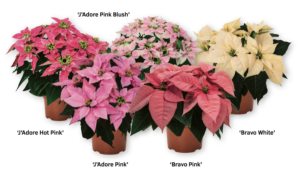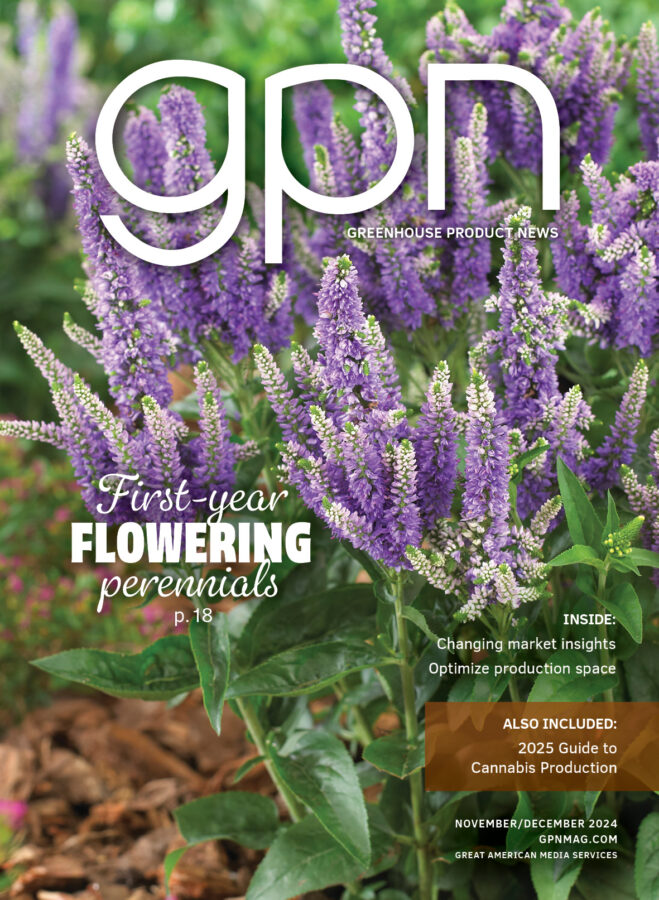
New Poinsettias for 2018 — How Did They Perform?
Happy 25th anniversary! In 1993, Jim Barrett, Allen Hammer and Roy Larson came together with the poinsettia breeders to create the National Poinsettia Trials. They evaluated 31 cultivars from three companies: Paul Ecke Ranch, Ball Horticultural and Mikkelsens in the first year. But change is inevitable. After Allen retired, the Purdue trials were run by Roberto Lopez before being moved to Ontario, where they were first managed by Wayne Brown and now by Mel Sawaya, who joined the trial program this year.
The move to Ontario happily necessitated changing the name to the North American Poinsettia Trials. The Florida trials are now run by Paul Fisher and George Grant. Starting next year, the North Carolina trials will be managed by Brian Whipker and Ingram McCall. Homewood Nursery and Garden Center, Raleigh, N.C., has continued to participate since the beginning of the trials.
Poinsettia cultivars also have changed over the last 25 years. Plant quality has greatly improved and the range of colors and forms is simply astounding, especially when you consider hybrids. Those trends were evident this year as well. In particular, breeders have been working to produce a V-shaped growth habit, which allows for stronger, upright plants and allows more plants to be grown per square foot of growing space.
With more than 130 cultivars evaluated, it was one of the largest trials ever. This report describes 21 cultivars that were newly released or newly introduced to the North American market. See tables for cultivar data and production information. In contrast to the first year, we had four companies that submitted cultivars: Ball/Selecta, Beekenkamp, Dümmen Orange and Syngenta, illustrating the changing corporate landscape as well.
We now have three series of hybrids on the market exhibiting an array of colors from the first true white bracts on poinsettias to fluorescent pink. Will these plants allow poinsettias to break into other holiday markets? Pink cultivars were sold in numbers in October for Breast Cancer Awareness Month. Maybe we will see one of the bright pinks or reds for Valentine’s Day?
Reds
‘Centurion’ (Beekenkamp). ‘Centurion’ has medium red bracts that lay flat in an attractive display. Bracts are on the small side. Plants have excellent branching and good stem strength. Foliage is dark green and rounded. Late season stretch was noticed at the University of Florida, which may necessitate a late PGR application. Plants flowered mid- season and have medium vigor, making them suitable for a range of container sizes.
‘Christmas Cheer’ (Ball/Selecta). ‘Christmas Cheer’ is a medium (North Carolina) to high vigor (Florida) cultivar that may require large amounts of PGRs to control growth in Florida. In fact, it might be best to shorten the schedule in warm climates. The plant is similar in appearance to ‘Christmas Day Red’ with medium to large dark red bracts that tend towards the blue side of red and hang down. Plants branched well and were uniform.
‘Christmas Magic’ (Ball/Selecta). ‘Christmas Magic’ is a compact plant with relatively few leaves below the bracts. This resulted in a slightly cramped bract display in North Carolina that would be improved by adding a week or two into the schedule. Plants showed first color early in Florida and North Carolina and also flowered early in North Carolina. In Florida, plants performed well and would be suitable for small to 6-inch containers with minimal PGRs required. The average-sized bracts were medium red and they are flat across the top of the plant. Plants had uniform branching.
‘Christmas Morning’ (Ball/Selecta). ‘Christmas Morning’ is best suited for tight production under cooler temperatures. Plants grew vigorously in Florida requiring several PGR applications versus very compact in North Carolina with no PGR needed. Plants have small to medium sized red bracts that are darker than most red cultivars. The dark green foliage is rounded. Plants flower early to mid season and have good branching. This cultivar was released last year, but was new to the trials this year.
‘Christmas Spirit’ (Ball/Selecta). ‘Christmas Spirit’ has large red bracts that hang down a bit producing the classic ball of red look. This early- to mid-season cultivar is fairly vigorous but is responsive to PGRs, which may be needed to control growth, especially early in the production schedule. Branching was good and growth was upright.
‘Lyra’ (Syngenta). ‘Lyra’ is an upright, easy-to-sleeve cultivar with attractive upright bracts. The bright red bracts have a hint of orange, allowing them to show well indoors. The medium green foliage is round. The early to mid-season plants have good branching and thick stems. University of Florida noted that ‘Lyra’ had the thickest stems of any Syngenta cultivar. The medium vigor plants are responsive to PGRs and can be grown in a range of container sizes.
‘Mirage’ (Syngenta). ‘Mirage’ is a compact (North Carolina) to medium vigor (Florida) cultivar with upright branching, thick stems and good bract presentation as they are slightly upright. The medium red bracts are rounded and the foliage dark green. Plants flowered early to mid-season and are responsive to PGRs.
‘Prima Bella’ (Dümmen Orange). ‘Prime Bella’ naturally grows in a V-shape design, which produces a large number of bracts on the top of plant. Bract size is smaller than typical poinsettias. Plants sleeve easily with less bract damage and branch breakage, ultimately reducing loss in quality during transportation. ‘Prima Bella’ is highly vigorous and will likely require multiple PGR applications to control height in Florida.
‘Robyn’ (Beekenkamp). ‘Robyn’ is a low to medium vigor plant with a great presentation of medium-sized red bracts. Plants have dark green rounded leaves and strong branches. University of Florida noted that Robyn had very thick stems, among the thickest of all of the cultivars trialed. In North Carolina, stems were also thick and strong but not above average. Plants were uniform and flowered mid-season.
Colors
Bravo: Pink and White (Dümmen Orange). Bravo Pink and White were well matched to ‘Bravo Bright Red’, except that Pink flowered slightly later and had the largest bracts. Plants are low to medium vigor, performing well in 61⁄2 inch or small containers. In warmer conditions, plants finished around 16 inches without PGRs. These strong cultivars had a great V-shape making for easy sleeving. ‘Bravo Pink’ bracts were a bright slightly salmon pink. The older bracts exhibited some of the slightly gray cast we find on many pink cultivars, but ‘Bravo Pink’ had less of this trait than most cultivars. ‘Bravo White’ was a creamy white with a hint of brown under cool conditions.
 Christmas Beauty: Cinnamon and Marble (Ball/Selecta). ‘Christmas Beauty Cinnamon’ is the newest novelty addition to the Christmas Beauty series. ‘Christmas Beauty Marble’ was released last year but was new to this trial. Both cultivars had similar low-medium vigor compared to the rest of the Christmas Beauty series and require a similar PGR regiment. As with all of the Christmas Beauty series, plants perform and finish well in warmer Southeastern conditions. Good branching habit allows for a compact final product. The upright, V-shaped architecture allows for easy handling, sleeving and transportation. Visually, this cultivar is similar to ‘Christmas Beauty Queen’ with a softer pink bract. ‘Christmas Beauty Marble’ has a dark pink blaze in the bracts, which are edged in very dark cream. The bracts in North Carolina had a tendency to curl up and even the older bracts exhibited some of this trait.
Christmas Beauty: Cinnamon and Marble (Ball/Selecta). ‘Christmas Beauty Cinnamon’ is the newest novelty addition to the Christmas Beauty series. ‘Christmas Beauty Marble’ was released last year but was new to this trial. Both cultivars had similar low-medium vigor compared to the rest of the Christmas Beauty series and require a similar PGR regiment. As with all of the Christmas Beauty series, plants perform and finish well in warmer Southeastern conditions. Good branching habit allows for a compact final product. The upright, V-shaped architecture allows for easy handling, sleeving and transportation. Visually, this cultivar is similar to ‘Christmas Beauty Queen’ with a softer pink bract. ‘Christmas Beauty Marble’ has a dark pink blaze in the bracts, which are edged in very dark cream. The bracts in North Carolina had a tendency to curl up and even the older bracts exhibited some of this trait.
Hybrids
J’Adore: Hot Pink, Pink and Pink Blush (Dümmen Orange). With a natural vigor midway between the Luv-U series and the Princettias, the J’Adore series works well for 6- to 8-inch containers. Plants are adaptable and can be grown in small pots as they are responsive to PGRs or in large containers with time added to the schedule. Pink Blush is the most compact and shows first color later than the other colors. While Hot Pink officially flowered later than the other two colors, anthesis can be hard to judge on these plants and all three colors have a long marketing period.
Three colors are available ranging from light pink (aging to white) to light pink to bright pink. For reference, the J’Adore Hot Pink is close to, but not as fluorescent pink as ‘Luv-U-Pink’. All three cultivars are characterized by very large, open centers with many cyathia. Unlike plants in the Luv-U series that tend to not develop cyathia or drop them early, the J’Adore series holds cyathia well but tend to drop a light carpet of anthers and pollen. Foliage is dark green, elongated and plants have uniform branching. Although stems are not particularly thick, plants are strong and hold their branches well when sleeved or transported. Late season PGR applications will maintain uniformity and reduce stretching without reducing bract size.
Princettia: Dark Pink, Hot Pink, Pink Queen, Red and Pure White (Dümmen Orange). Princettias are quite different than the other hybrids in a number of ways. First, the plants are much more compact, especially Pure White, and cyathia clusters are close in size and style to traditional poinsettias. University of Florida trial noted that not all plants developed pollen- producing anthers and some of the cyathia dropped prior to reaching anthesis. Combined with the prolific branching, the Princettias display a myriad of white, pink or red stars on top of the dark green foliage. In fact, the Princettia series is probably the closest in look to the regular poinsettias. Plants are naturally well suited to containers less than 6-inches in diameter but can be easily grown in larger containers with additional time in the schedule. In the middle or northern areas, add at least two weeks for the pinks and three weeks for the white. ‘Princettia Pink Queen’ had the largest growth habit and bract size of the series, with Pure White and Hot Pink generally the most compact. Overall, the Princettia line required little to no PGR applications even in warmer conditions.
Colors ranged from the truest white available in poinsettias, on the appropriately named Pure White cultivar, to Red. The latter had a few small flecks of pink on the bracts. Of the pinks, Pink Queen was closest in color to Luv-U-Pink, while Dark Pink was darker and Hot Pink brighter than Pink Queen. Finishing Dark Pink under cool conditions will bring out a purplish bract color. Foliage is dark green and elongated. Plants flowered early to mid-season.






 Video Library
Video Library 



















